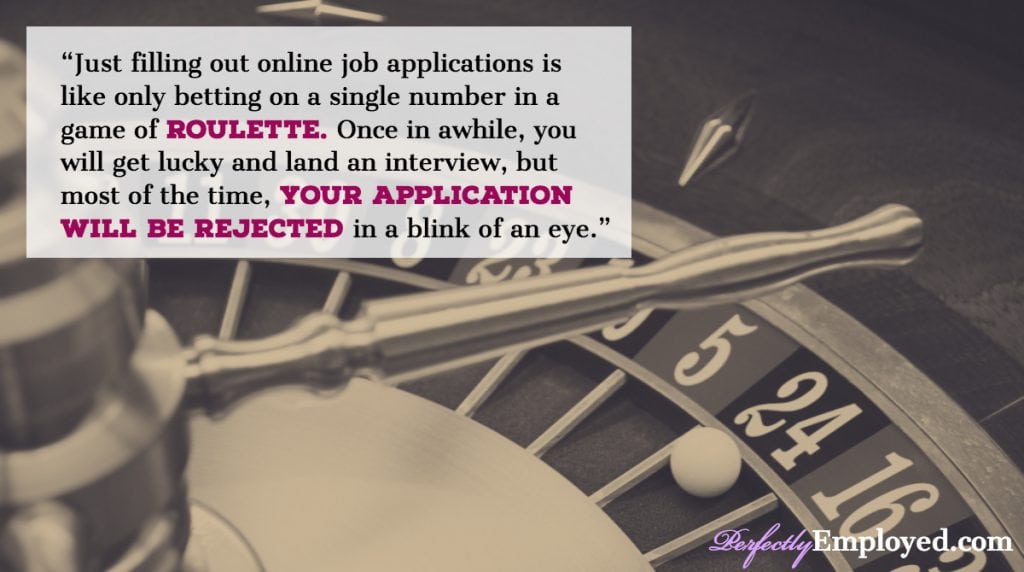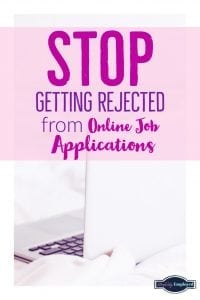
Employers are rejecting as many as 98% of all online job applications and resumes. It’s a shocking statistic, but it should also make you think a little harder about how you’re searching for jobs. You can’t just fill out a bunch of online job applications and think you’re going to find a job quickly.
Just filling out online job applications is like only betting on a single number in a game of roulette. Once in awhile, you will get lucky and land an interview, but most of the time, your application will be rejected in a blink of an eye. You must have a job search strategy.

Online job applications are still vital, though, because it’s the only way most companies accept applications. Your online application has to shine, but you have to take a few strategic steps to ensure your application is seen by the person with the power to hire you.
Make Sure You Meet the Minimum Qualifications—and Your Application Shows It
In most cases, your application will be automatically rejected if you do not meet the minimum qualifications. Many application software systems are set to auto-reject applicants who do not meet minimum qualifications before human eyes ever see the application. The bottom line: If you don’t meet at least the minimum requirements, you’re wasting your time in applying for a job online.
Even more, your application materials need to show, very clearly, that you do meet the minimum qualifications. Here’s how:
- Make a list of the minimum and recommended qualifications listed in the advertisement.
- Draft a cover letter that explains how you meet the qualifications.
- Go through your resume and make sure your professional profile or summary lists the qualifications listed in the ad. Echo the wording the employer uses in the ad.
- When you’re filling out the application, make sure the descriptions of your previous jobs use the keywords the employer used in their qualifications list.
Remember that your goal is to show the employer that you’re the perfect person for the job. Take the time to make sure all of your application materials show you’re qualified and the right people will see your application.
Get an Internal Recommendation: Network Your Way to an Interview
One of the best ways to ensure the right people see your application is to get an internal recommendation from someone who already works in the company. Internal recommendations hold a lot of weight with employers because if a current employee does excellent work, the employer assumes that the people he or she respects enough to recommend with do excellent work, too.
Bigger corporations have special employee recruitment systems built specifically for internal recommendations. Some companies even guarantee an interview for applicants with internal recommendations!
Many companies offer referral bonuses when an employee makes a recommendation and the recommended applicant is hired. I made $500 when I recommended a fellow instructional designer for a contract job at a big corporation. It’s a win-win for everyone involved: The employer gets help weeding through applicants, the person making the recommendation gets a bonus and the satisfaction of helping a colleague, and the applicant gets a job.
There are a few ways to go about getting an internal recommendation. Start by asking people in your network if they know of any open positions at the places they work that would be suitable for you. Many positions are advertised internally before they are advertised publicly. Don’t be afraid to ask—that’s the purpose of building a network!
Next, as you’re looking through job advertisements, use LinkedIN to see who you know, or who in your network knows someone that works at the companies advertising jobs you want. Make connections and ask for internal recommendations.
Follow up with the Hiring Manager
If you are applying for a local company or retail store, you should find out who the hiring manager is and follow up with him or her within a couple days of filling out an online application. If it’s a retail job, you should go to the store in person, introduce yourself, hand your resume to the hiring manager, and tell them you’d love to work there and how you’re highly qualified for the job.
With a local business, you might start by finding the hiring manager’s email address and writing a kind email introducing yourself. Explain that you’ve already applied for the job, but you wanted to personally reach out and let the hiring manager know how excited you are by the opportunity to potential work with the local company. Give a short summary of your qualifications, attach your resume, and say thank you.
The point is, if you have the opportunity to make a personal connection, you should do it.
[bctt tweet=”Do whatever you can to stand out from the giant pile of other applicants. Meet people, make an impression, and let them know you’re kind and qualified.”]
Keyword Optimization
Modern application software allows HR representatives and hiring managers to comb through applications for specific keywords. They may search your application for your previous job titles to see if you’ve worked similar jobs in the past. They may search for specific skills they need from applicants, like industry-specific software. Be aware that employers have the ability to search through applications this way and prepare for it.
If you’ve tooled your cover letter, resume, and application to show that you meet the minimum qualifications for the job, you already have a good jump on keyword optimization. The process is very similar:
- Read through the job advertisement and make a list of specific skills, software, job duties, and other qualifications that stand out in the ad. These can all be keywords.
- Go through your resume and retool the language in your previous job descriptions to match the keywords from the job duties listed in the advertisement.
- Retool the language in your cover letter and resume’s personal profile or summary to make sure you’re hitting keywords for specific skills and qualifications.
- When you list previous jobs and skills on the job application, be sure to use keywords from the ad.
The goal is to use as many keywords from the ad as possible. Sometimes keywords aren’t in the ad, and you will have to know your industry and the company to add them to your materials. If you don’t have a good list of keywords from the advertisement, you can always use LinkedIN to look at profiles of people who work at the company and use keywords from their qualifications.
Avoid Scoring System Pitfalls
Modern application software sometimes use a “scoring system” to rank applicants based on keywords, qualifications, and experience. If you’ve done everything we’ve talked about so far, you should be scoring quite well in these systems. However, employers can set other factors besides skills, qualifications, and experience as part of the scoring system.
For example, we’ve seen some government jobs where applicants are automatically rejected if they answer “yes” to the “do you use tobacco products” question. Some are rejecting applicants who have been arrested (without reading explanations). Still others are auto-rejecting applicants who have been fired from previous jobs.
Auto-rejection isn’t fair. If you are rejected for a job quickly, in so short a time frame that you’re pretty sure no one looked at your application, you can try emailing an explanation to the HR department and see if it makes a difference. The worst thing they can do is tell you that your application is still rejected, so you have nothing to lose.
Keep Trying and Don’t Take it Personally
Just because a company rejects your application once doesn’t mean you shouldn’t try applying there again. As you practice making lists of keywords specific to the job advertisement and retooling your materials to fit them, you will get a lot more interview calls. Keep practicing and honing your application skills!
Save to Pinterest



